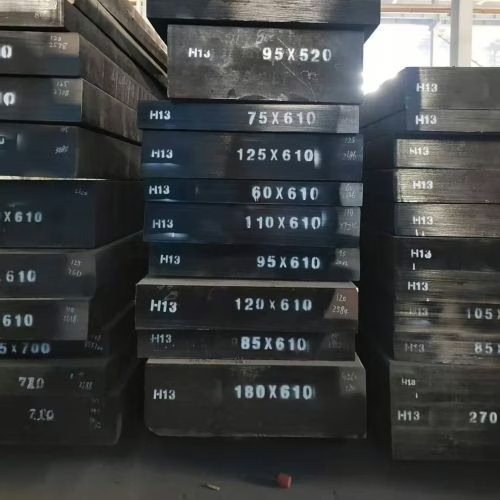H13 Steel Properties
Choosing the right material is fundamental for success in demanding applications, particularly in hot work tooling. A thorough understanding of H13 steel properties ensures reliability and peak performance in your operations. H13 tool steel stands out within the 5% Chromium hot-work die steel family, recognized globally for its exceptional strength and durability under thermal stress. Let’s examine the characteristics that make H13 a preferred choice for tough jobs. You can download the H13 material properties PDF for free at the bottom of the page.
1. Core Characteristics: What Defines H13 Steel?
H13 is technically a medium-alloy air-hardening steel, yet its performance capabilities place it firmly in the ultrahigh-strength steel category. Through appropriate heat treatment, it achieves yield strengths exceeding 1380 MPa (200 ksi). This inherent strength, combined with other vital attributes, provides remarkable versatility.

1.1 Chemical Composition and Microstructure
The basis for all H13 steel properties is its precise chemical composition. While sharing similarities with H11 Mod, H13 is distinguished by its higher vanadium content, typically around 1%. The standard composition includes:
- Carbon: 0.35-0.45%
- Chromium: 4.75-5.50%
- Molybdenum: 1.10-1.75%
- Vanadium: 0.80-1.20%
- Silicon: 0.80-1.25%
- Manganese: 0.20-0.60%
Correct heat treatment yields a microstructure of martensite and fine pearlite, crucially reinforced by vanadium, molybdenum, and chromium carbides (MC, M6C, M23C6). Achieving a fine, homogenous distribution of these carbides is essential for maximizing toughness. Aobo Steel‘s extensive forging experience ensures meticulous control over these microstructural factors. Careful management of impurities like phosphorus and sulfur is standard practice to maintain material integrity.
1.2 Heat Treatment: Unlocking H13 Potential
A significant practical advantage among H13 steel properties is its air-hardening nature. This simplifies heat treatment, especially for larger components, effectively minimizing distortion and residual stresses post-hardening. The chromium and molybdenum content guarantee excellent hardenability through the cross-section.
H13 greatly benefits from secondary hardening via tempering above 510 °C (950 °F). Such high tempering temperatures relieve stress and stabilize the steel’s structure, making it ideal for tools subjected to elevated service temperatures. Double tempering is generally recommended for achieving optimal, consistent properties. Proper annealing procedures ensure good machinability before final treatment. To prevent surface issues like decarburization, controlled atmosphere or vacuum heat treatment is advised for critical components.
2. Key Mechanical and Physical H13 Steel Properties
The mechanical performance characteristics are critical for evaluating H13’s suitability for specific tooling demands.
2.1 Strength, Hardness, and Toughness
H13 provides a superior balance of mechanical properties. It’s capable of reaching tensile strengths above 2070 MPa (300 ksi). The final hardness and toughness levels are directly influenced by the selected tempering temperature. Typical examples include:
- Tempered at 540 °C (1000 °F): Hardness ~56 HRC, Tensile Strength ~2010 MPa, Yield Strength ~1675 MPa, Impact Energy ~21 J.
- Tempered at 595 °C (1100 °F): Hardness ~45 HRC, Tensile Strength ~1540 MPa, Yield Strength ~1320 MPa, Impact Energy ~31 J.
While possessing good toughness, its fracture toughness is generally slightly below that of H11 Mod, primarily due to the influence of vanadium carbides. However, its overall property combination remains highly effective for numerous applications.
2.2 Wear Resistance and High-Temperature Performance
Outstanding wear resistance is a key H13 steel property, directly linked to the presence of hard vanadium carbides. This attribute provides high resistance to abrasion in harsh working environments.
Additionally, H13 demonstrates good “red hardness”—the ability to retain hardness at high operational temperatures—along with very good resistance to thermal fatigue and heat checking. This allows it to endure cyclic heating and cooling, characteristic of many hot work processes. It can be water-cooled during service if necessary. For applications requiring extreme surface durability, such as forging or extrusion tooling, nitriding treatments can be applied to achieve surface hardness exceeding 1000 HV.
3. Common Applications and Processing
The robust profile of H13 steel properties makes it a primary material choice for:
- Die casting dies (handling aluminum, magnesium, zinc alloys)
- Hot forging dies and inserts
- Extrusion dies for metals and plastics
- Plastic injection molds requiring high durability
- Mandrels, punches, and other hot work tooling components
Its thermal stability permits reliable use at temperatures up to approximately 55°C below the final tempering temperature. Beyond tooling, H13 offers good weldability (typically using matching H13 filler material) and acceptable thermal conductivity, enhancing its utility.
Aobo Steel utilizes advanced refining processes such as ESR (Electro-Slag Remelting) when required, enhancing material cleanliness and structural homogeneity. This translates to improved toughness and consistency, which are particularly vital for demanding applications. Our 20+ years dedicated to tool steel forging and strong supplier relationships guarantee material quality you can trust.
4. Why Aobo Steel for H13?
Understanding H13 steel properties on paper is important, but partnering with an experienced supplier like Aobo Steel translates that knowledge into reliable material performance. We leverage over two decades of specialized tool steel expertise to provide H13 processed optimally for your specific requirements.
If H13 is being considered for your application, contact Aobo Steel. Let’s discuss your operational parameters—temperature, stress loads, and wear factors. We can confirm if H13 is the ideal solution or recommend alternatives if needed. Visit us at www.aobosteel.com.
Click the button below to download H13 material properties PDF
Explore Our Other Products
D2/1.2379/SKD11
D3/1.2080/SKD1
D6/1.2436/SKD2
A2/1.23663/SKD12
O1/1.2510/SKS3
O2/1.2842
S1/1.2550
S7/1.2355
DC53
H13/1.2344/SKD61
H11/1.2343/SKD6
H21/1.2581/SKD7
L6/1.2714/SKT4
M2/1.3343/SKH51
M35/1.3243/SKH55
M42/1.3247/SKH59
P20/1.2311
P20+Ni/1.2738
420/1.2083/2Cr13
422 stainless steel
52100 bearing steel
440C stainless steel
4140/42CrMo4/SCM440
4340/34CrNiMo6/1.6582
4130
5140/42Cr4/SCR440
SCM415
Unlock Peak Performance with Premium H13 Tool Steel
Leverage Aobo Steel's 20+ years of forging expertise for superior H13 tool steel. Get the toughness, heat resistance, and reliability your demanding applications require.
- ✔ Exceptional hot hardness and wear resistance.
- ✔ Outstanding toughness and ductility.
- ✔ Consistent quality backed by decades of experience.
- ✔ Competitive pricing and reliable supply chain.
Ready to enhance your production? Get a personalized quote for H13 Tool Steel today!
Fill out the form below to connect with our experts.
